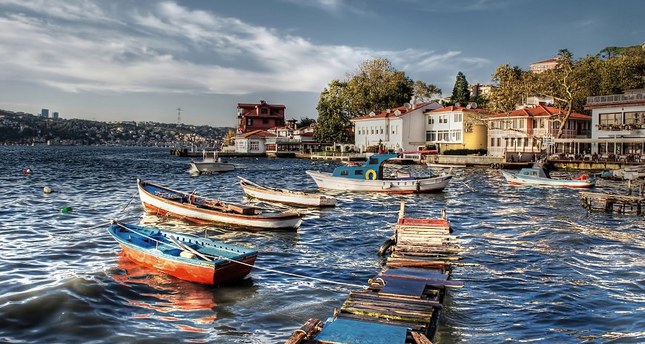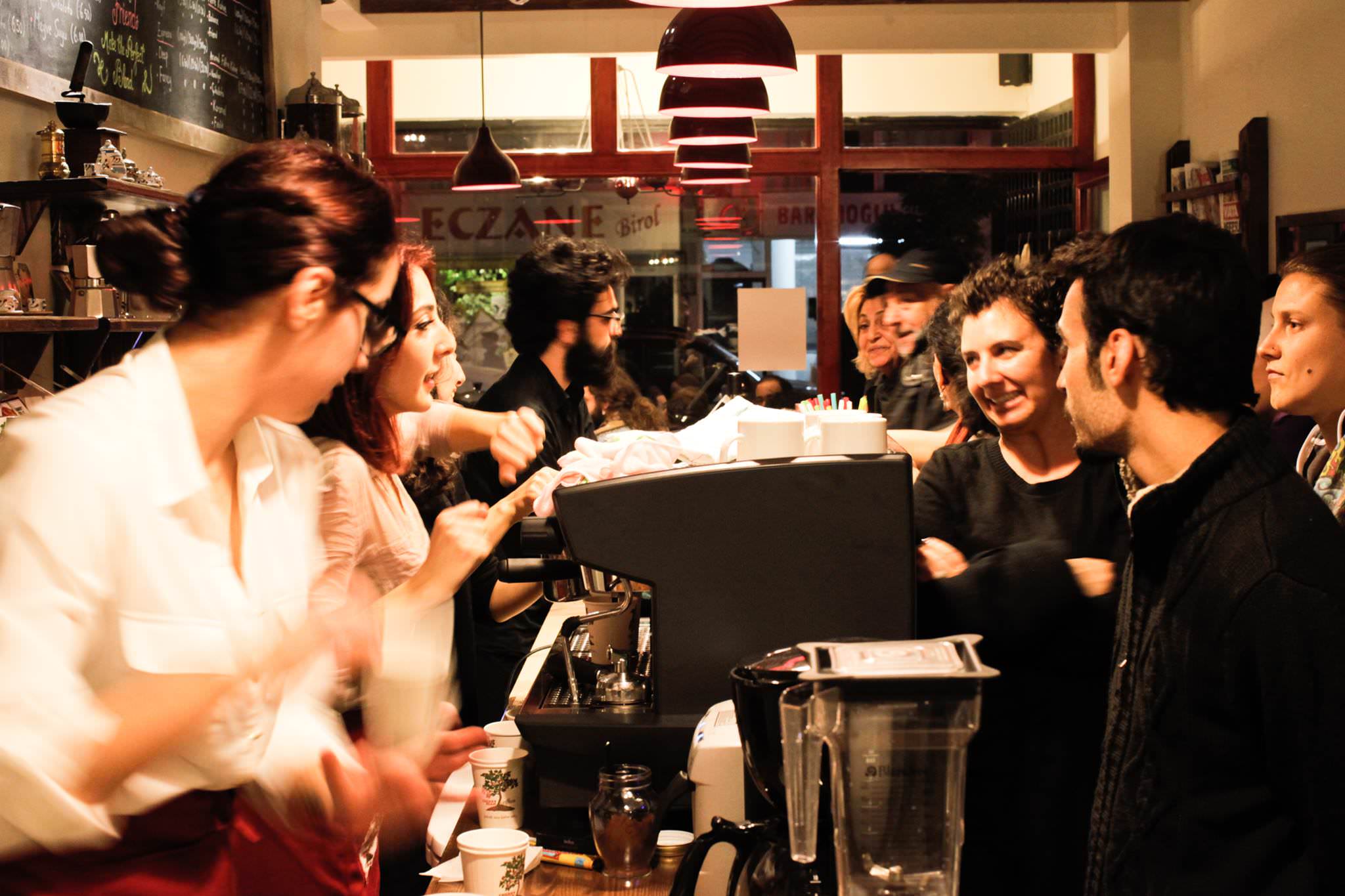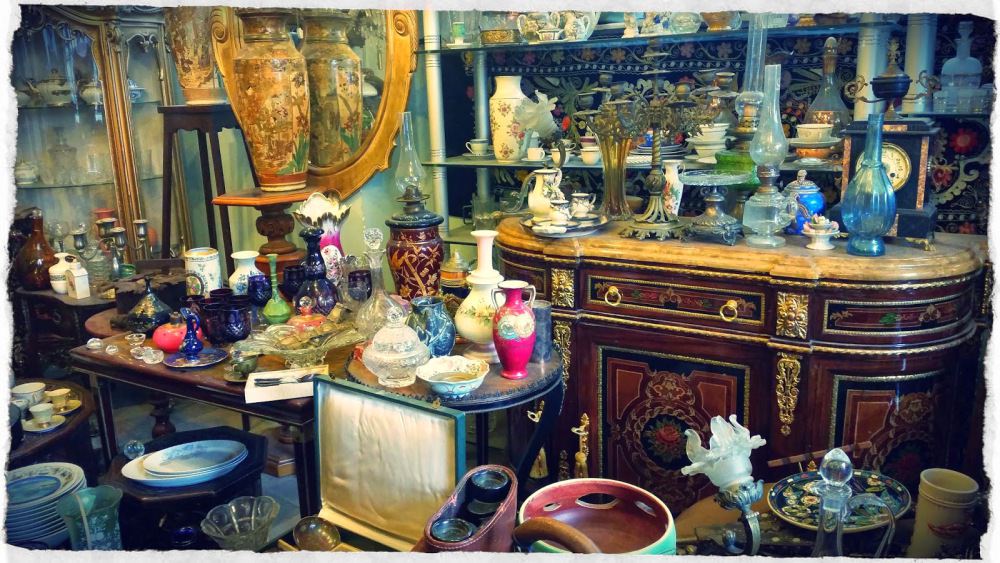Mavi Boncuk |Hilmi Yavuz'dan 80 yıllık yaşamının muhasebesi: SÜKUT-U HAYAL VE HÜSRAN
Genç Cumhuriyet’ten bugüne çok önemli dönemlere tanıklık eden Hilmi Yavuz günümüz olaylarını şöyle özetliyor: "Türkiye’nin gerçek bir demokrasiye geçmesi için en az iki yüz yıl daha gerekli. Onda da bir garanti yok"
Fatih VURAL
O, Türkiye’nin en büyük şairlerinden biri değil sadece… Çok önemli bir yazar, filozof ve hoca… Rahle-i tedrisinden geçen yüzlerce öğrenciyle de bu topraklara yeni tohumlar ekti. Bilkent Üniversitesi’nde ekmeye de devam ediyor.
Bu yıl 80 yaşına giren Hilmi Yavuz, genç Cumhuriyet’ten bugüne kadar çok önemli dönemlere tanıklık etti. Yaşadığımız bugünleri, ‘lümpenliğin zirve yaptığı dönem’ olarak gören Yavuz, gelecekten hiç de ümitli değil! 80 yılı "sükut-u hayal ve hüsran" olarak özetliyor. “Tayyip Bey gidecek, başka birisi gelecek. Yine ara bir demokrasi dönem yaşayacağız ve kısa sürede bitecek. Türkiye’nin gerçek bir demokrasiye geçmesi için en az iki yüz yıl daha gerekli. Onda da bir garanti yok” diyen Yavuz, sözlerini şöyle tamamlıyor: “Türkiye demokrat o-la-maz!”
Cumhuriyet’in kuruluşundan bu yana aydın ve iktidar ilişkisi nasıl bir düzlem üzerinden yürüdü?
Tanzimat’tan bu yana, entelektüel kimlikleri olduğunu söyleyebileceğimiz birtakım insanlar var. Onlara gerçekten aydın diyebilir miyiz, şüpheliyim. Tanzimat’ta Şinasi’den söz edersek, tamamıyla Batıcı bir adamdır. Ahmet Cevdet Paşa’dan söz edersek tamamıyla gelenekselci bir kimliktir. 2. Meşrutiyet’e geldiğimizde, Şinasi’nin kimliğinin devamı olarak Batıcı, modern anlayış iki düzlemde yürümeye başladı: Pozitivistler ve materyalistler. Pozitivistlerin arasında Ahmet Nebil’ler, materyalistlerin arasında Baha Tevfik’ler var.
MATERYALİSTLER MARKSİST, POZİTİVİSTLER İSE KEMALİST OLDU
Ya Cumhuriyet dönemi?
Cumhuriyet dönemine gelindiğinde 2. Meşrutiyet’in materyalistleri Marksist, 2. Meşrutiyet’in pozitivistleri de Kemalist oluyor. Böylesine bir dönüşüm var. 1930’lardaki Kadro dergisinde ve daha sonra Doğan Avcıoğlu’nun Yön dergisinde Marksist ve Kemalistler arasında bir uzlaştırma çabası gözümüze çarpar. Kemalistler iktidarla ‘organik aydın’ olarak bütünleşirken, Marksistler ‘organik aydın’ların karşısında muhalefeti temsil eder olmuştur.
Cumhuriyet döneminde iktidara karşı muhalefet, hem Batıcı ve modernleşmeci Marksist aydınlar, hem de muhafazakâr, İslamcı aydınlar tarafından yürütülüyor. Sait Halim Paşa, Felibeli Ahmed Hilmi gibi İslamcı muhaliflerin, 2. Meşrutiyet döneminde olduğunu da unutmayalım.
HALİDÎ KOLU, NAKŞİBENDİLİĞİ SİYASİLEŞTİRDİ
Cumhuriyet dönemindeki İslamcı aydınları, bunların devamı olarak okuyabilir miyiz?
Elbette. İslamcı muhalif entelektüellerin daha çok ve özellikle Nakşibendiler arasından çıktığını görüyoruz. ‘Halidî Nakşibendiler’ diye bilinen grubun iki büyük kimliği vardır. Bir tarafta Abdülhakim Arvasi, diğer tarafta Abdülaziz Bekkine vardır. Arvasi’den Necip Fazıl, Bekkine’den ise Nurettin Topçu akımı devam eder. Topçu’nun grubu, bugün daha ziyade Dergâh dergisinin çevresinde toplanan kimliktir. Necip Fazıl’ın Büyük Doğu grubu ile Dergâh grubu arasında bugün dahi ciddi bir rekabet söz konusudur. Bunlar tamamen Nakşibendilik üzerinden bir İslami muhalefet oluşturdular. Halidî Nakşibendilik, Nakşibendi tarikatının doğrudan doğruya politik bir misyonu olması ve bu anlamda dünyevileşmesi gerektiği üzerinde durmuştur.
MARKSİST BAZI AYDINLAR, BİRDEN İKTİDARIN ADAMI OLUVERDİ!
Marksist ve İslamcı muhalif aydınlar, Demokrat Parti’nin kuruluşu sırasında bir araya geliyorlar, değil mi?
Evet, doğru. Sertel Ailesi, başlangıçta Demokrat Parti’yi destekledi. Şevket Süreyya Aydemir ise çok uzun bir süre Demokrat Parti’yi destekledi. Bu işbirlikleri ilginçtir ve bende, onlara dair, bir sınıf bilincine sahip olmadıkları fikrini uyandırmıştır.
Nazım ve Kerim Sadi için bunu söyleyemem. Vedat Nedim mesela… Gizli Komünist Parti’nin genel sekteridir. Ama ne oldu, İsmet Paşa döneminde Radyo Müdürlüğü yaptı. Kadro Hareketi içinde Vedat Nedim’le birlikte Yakup Kadri, İsmail Hüsrev’le birlikte yer almış Şevket Süreyya da 2. Dünya Savaşı döneminde, CHP’ye bağlı olarak İaşe Müsteşarlığı yapmıştır. Adam komünist, sonra birdenbire iktidarın adamı oluyor!
Onları da anlayabiliyorum, zira Kadro dergisinde Marksizm’le Kemalizm’i uzlaştırmaya çalıştılar. Ama bu uzlaşıyı Mustafa Kemal kabul etmedi. Kadro dergisi de onun emriyle kapatıldı. Derginin ilk sayısında Başbakan İsmet Paşa’nın önsözü vardır. Kapatılma sonucunda, hareket içindeki isimler, CHP ile bütünleşmeye gitmiştir.
27 Mayıs’tan sonraki aydın panoraması bize neler söylüyor?
Darbeden sonra, 1961 sonunda, Doğan Avcıoğlu yönetiminde Yön dergisi kurulur. İlhan Selçuk, Şevket Süreyya gibi isimler, bu hareketi desteklemiştir. Bunun yanı sıra, ayrıca bir Marksist hareket de vardır.
Türkiye İşçi Partisi…
Evet. Bu defa İşçi Partisi’nin içinde bir bölünme ve rekabet başlar. Milli Demokratik Devrimciler (MDD), bir devrimin ancak askeri darbenin sonucunda gerçekleşeceğini iddia eder.
O sürece kadar en ağır bedeli ödeyenler sosyalistler, komünistler mi oluyor?
İslamcılar da büyük bedel ödüyor. Bediüzzaman’ı düşünün, o da Nakşi’dir… Necip Fazıl’ı düşünün… Çok sayıda İslamcı okur-yazar, hem CHP, hem de DP döneminde ciddi haksızlara uğramıştır.
TOPLUM, DESPOTİZM DIŞINDA BİR YAŞAMA BİÇİMİ KAZANAMADI
Tek parti döneminde ideolojik olarak yürütülen iki yönlü bir cadı avı var. ‘Komünist’ diye bakılanlara yapılanlar arasında, Tan Matbaası’nın yıkılışını, Sertel’lerin kaçmaya zorlanmalarını, Nâzım’ın yok yere 12 yıl hapis yatmasını, Sabahattin Ali’nin öldürülmesini sayabiliriz. Daha sonra hortlatılan ‘şeriat’ tehlikesi altında özellikle Said Nursi’ye yapılan zulümleri biliyoruz. Devlet sürekli bir düşmanlık kodu mu üretiyor?
Türkiye’de siyasal muhalefetin, herhangi biçimde, özellikle de entelektüeller bakımından, toleransla karşılandığını söylemek mümkün değil! Bu, devletin yapısıyla ilgili bir meseledir. Türkiye Cumhuriyeti de dâhil olmak üzere, demokrasi, arızi bir ortam olmuştur. Yani bizde askeri ya da sivil despotizm ve vesayet esastır! Demokrasi ise füruattır! Yani öncelikli değildir.
1923’ten 2016’ya kadar kaç yıl askeri ve sivil vesayetle, kaç yıl demokrasiyle geçmiştir? 1923’ten 1950’ye kadar daha en başta avans verilmiş! Bunun bir despotizm olmadığını söylemek mümkün mü? Sonra Menderes geliyor. 5 yıllık bir demokrasi oluyor.
1955’ten sonra Menderes despotizmi başlıyor. O bitiyor, 27 Mayıs Darbesi oluyor. Askeri vesayet başlıyor. 1961-1962’den 1971’e kadar Türkiye’de yine bir demokrasi var. 12 Mart 1971’le yine bir despotizm geliyor. Arada kısa bir demokrasi süreci var. Sonra küt diye 12 Eylül 1980 Darbesi çıkageliyor.
Bunlara bakarak, Türkiye’nin demokrat mı, despotik mi olduğunu anlamak çok kolay. Despotizm arası demokrasiler, ara rejimler! Parlamento’nun olması, insanların seçimle iş başına gelmesi, o ülkenin demokrat olduğunu göstermez. Menderes de seçimle iş başına gelmiştir, Tayyip Bey de seçimle iş başına gelmiştir! Bu toplum, despotik bir yapılanmanın dışında kendisine demokrasiyi üretme imkânı bulamıyorsa, o zaman bu toplumda muhaliflere hiçbir şekilde kendi görüşlerini dile getirme olanağı verilmeyecektir. Bu toplum, despotizm dışında bir siyasal yaşama biçimini henüz kazanabilmiş değil!
“YETMEZ AMA EVET”Çİ DEĞİL, DİREKT “EVET”ÇİYDİM!
AK Parti döneminde ‘despotizm-ara rejim demokrasi’ döngüsünün kırılacağına inandınız mı?
Evet! Sol bunu yapamadı. Dolayısıyla, Türkiye’de demokratikleşmenin olsa olsa sağdan ve muhafazakârlıktan gelebileceği konusunda belki çok naif bir hassasiyet oluştu bende.
İnsanlar, özellikle 28 Şubat döneminde başlayan ‘mazlumluk’ kavramının tuzağına mı düştü?
Evet! Bu önemli bir noktadır… Referandumda ben, “Yetmez Ama Evet”çi değildim! Ben, direkt “Evet”çiydim! Üç gerekçem vardı. Bir, Genelkurmay Başkanı Yaşar Büyükanıt’ı şüpheli sıfatıyla sorguya çekmek isteyen Van Savcısı Ferhat Sarıkaya, HSYK kararıyla savcılıktan uzaklaştırıldı. Bununla kalmadı, meslekten ihraç edildi.
İki, Abdullah Gül’ün Cumhurbaşkanlığı seçimi sırasındaki Sabih Kanadoğlu formülasyonu: 367. Ondan önceki hiçbir aday böyle bir dayatmayla karşılaşmamış! Anayasa Mahkemesi de bunu onayladı. Üç, TSK’dan birtakım insanların, eşleri başörtülü ya da kendileri karargâhta namaz kılıyor diye ordudan tard edilmesi. Bunların başvuracakları bir makam da yoktu.
TAYYİP BEY’İN TEK ADAM OLMAK İSTEDİĞİNİ 2012’DE ANLADIM
Onlar arasında edebiyatçı İskender Pala da var…
Evet. Bu üç gerekçe, vicdanen benim kabul edebileceğim bir şey değil. Bunları da o dönemde yazdım. O nedenle referandumda “Evet” dedim. O zaman AK Parti bütün bu sorunlara, 28 Şubat despotizmine karşı bir alternatif getiriyordu. 2012’ye kadar da bu tavrı sürdürdüm.
Kopuş noktanız neresiydi?
Kopuş noktam, Tayyip Bey’in bu ülkeyi tek başına yönetme eğilimine kapılmış olmasıdır. 2012’deki bir yazımın sonunda Tayyip Bey için “Mağrur olma padişahım, senden büyük Allah var” demiştim. 17-25 Aralık ya da Gezi Olayları daha ortada yoktu.
SİYASAL İSLAM’IN TEK ADAMLIĞIN ÖNÜNE GEÇECEK ENTELEKTÜEL GÜCÜ YOK
Siyasal İslam’ın içindeki entelektüel unsurlar, Tayyip Bey’in tek adamlık arzusuna bir denetim mekanizması oluşturamaz mıydı? Ya da siyasal İslam’ın böylesine bir gücü var mıydı?
Siyasal İslam’ın böyle bir entelektüel gücü yok! Bunu anlama sürecimin bir başlangıcı var… Siyasal İslam, medeniyeti mi yoksa dogmaları mı yani akaidi mi referans alıyor? İkisinin birbirinden ayrılmazlığını düşünmek gerekir. Zira İslam aynı zamanda çok büyük estetik medeniyetidir.
SİYASAL İSLAM, MEHMED AKİF GİBİ MEDENİYETİ DIŞLADI
Bu anlamda hep Yahya Kemal örneğini verirsiniz…
Evet. Sermet Sami Uysal, Yahya Kemal’e sorar: “Üstadım siz de Müslümansınız, Mehmed Akif de. Aranızda ne fark var?” Yahya Kemal diyor ki: “Akif, akaidin şairidir. Ben, İslam şiirinin şairiyim.” Bu çok önemli bir tespittir. Yahya Kemal’in “İslam şiirinin şairi” ifadesinin kapsamını genişletebiliriz. Aslında “Ben, İslam medeniyetinin şairiyim” diyor, Yahya Kemal. İslam, bir estetik ve ahlak medeniyetidir. Böyle felsefi bir arka planı var. Artistik ve entelektüel…
Mevlânâ da “Zevki olmayanın imanı olmaz” diyor…
Doğru. Böyle olunca, bugünkü siyasal İslam’ın neyi öne çıkardığını ve neyi geriye ittiğini düşünmeye başladım. Akaidi yani Akif çizgisini öne çıkarıyor. Akif’i asla inkâr etmiyorum, çok büyük bir şair. Ama medeniyeti ‘tek dişe kalmış canavar’a benzetir. İslam’ın artistik ve ahlaki anlamda medeniyet boyutu geriye itilince siyasal İslam da ister istemez bir forma dönüşmüştür. Siyasal İslam, Türkiye’de, Müslümanlığı, altını çizerek söylüyorum, kamusal alanda görünür olmaya indirgemiştir.
DÜNYEVİLEŞTİKÇE MANEVİYATTAN VE AHLAKTAN UZAKLAŞTILAR
Bunu açar mısınız?
“Adam, evinde içki içer içmez. Beni ilgilendirmez. Meyhanede görünüyor! Adamın alnı evde secde-i Rahman’a değiyor mu, beni ilgilendirmez. Cuma namazına geliyor mu?” İslam’da her şeyden evvel bir Peygamber ahlakından söz edilir. Ama siyasal İslam’da bu yok! Bu da Nakşibendi tarikatının Halidî kolunun dünyevileşmesiyle ilgili. Ne kadar dünyaya dönük bir tavrı öne çıkıyorsa, manevi ve ahlaki yanı da geriye itiliyor.
İSMET ÖZEL SÖYLEDİ: “İSLAM’IN MEDENİYETE İHTİYACI YOK!”
Medeniyetten akaide kayış, bir medeniyet tasavvurunun olamadığının, olamayacağının itirafı mı?
Bunu söyleyenler oldu. “İslam’ın kendisi bir medeniyettir. Medeniyete ihtiyacı yoktur” gibi bir retorik üretildi. Bunu İsmet Özel söyledi. Başta ben olmak üzere birçok arkadaşımız da bu nedenle eleştirildi.
Hep zikrettiğiniz taassup noktasına burada mı kaydılar?
Kesinlikle öyle. Estetik ve ahlak medeniyeti, kendiliğinden bir tolerans anlayışını da beraberinde getirir. Böylesine bir yoksunluk da bugünkü sonuçları, taassubu doğurdu.
TÜRGEV Mİ SİVİL?
Özellikle kamusal alandaki taassuba dayalı bakış açısı, laikçi endişeleri de haklı çıkarıyor mu?
Türkiye’de hiçbir kavram açık ve seçik biçimde tarif edilmiş değil. “Kamusal alan” dediğimiz zaman ne anlıyoruz? Kamusal alanı, sivil toplumu kimse tarif etmiyor. Tayyip Bey, “STK’ları topladım” diyor. Aralarında TÜRGEV var! TÜRGEV, STK mı? Bir yapının sivil olması için her şeyden önce devletten özerk olması lazım.
BEN DE AYNI GEMİDEYİM
İngilizce karşılığı da ‘devletten bağımsız’ demek…
Evet. Hükümetin ideolojisiyle organik bir ilişkiye girmiş herhangi bir kurum, sivil toplum kuruluşu değildir. Entelektüel anlamda tam bir kafa karışıklığı hâkim. Bir kavramsal zemin olmazsa düşünce üretimi de olmaz.
O zeminin yokluğu, entelektüel asgari müştereklerin dahi olamamasından mı kaynaklanıyor? Bir diyalog problemi mi var?
Bu, Tanzimat’a kadar uzuyor. Düşüncede tarihsel süreklilik ve devamlılık yok. Kendi geçmişimizi bilmiyoruz. Batı’yı da sadece birtakım kavramları tanımlamadan ele alıyoruz. Hem gelenekseli hem de moderni birlikte edinebilme imkânına sahip olsaydık, böyle bir derbederliğin içine düşmezdik. Ben de aynı gemideyim. Ama daha eleştirel bakıyorum.
BİR KARŞILIK BULMA BEKLENTİM BİTTİ!
Bu gemide olmanın size ödettiği en ağır bedel neydi?
Sükût-u hayal ve hüsran! Bir şeyler söylediğimde bir karşılığını bulabilme iyimserliğiyle konuşuyordum. Artık böyle bir iyimserliğim yok! Çünkü her şey sebeplere değil, gerekçelere indirgedi. Söylediğiniz şeyin tartışılmasından ziyade, sizin onu neden söylediğiniz önemli bugün. Tipik bir örnek vereyim, bundan yirmi sene önce Enis Batur tasavvuf üzerine bir yazı yazdı. Tasavvuftaki ‘vahdet-i vücud’u, ‘gövde’ zannetti! “Tasavvuf, gövdelerin birliğidir” dedi. Ben de bir yazı yazdım: “Enis Batur, vahdet-i vücud’u, Brigitte Bardo’nun vücudu zannediyor!”
ALEV ALATLI’YLA CELAL ŞENGÖR’E Mİ AYDIN DİYECEĞİZ?
Reaksiyonları ne oldu?
“Ağabey sen neden Enis’e böyle dedin?” Doğruyu söyleyip söylemediğime bakılmadı. Okuma Notları diye bir kitap yazdım, Türkiye’de dil bilmeyen okura bir hizmet olsun diye… Bazı çeviriler alarak, bildiğim yabancı dillerde, o çevirileri karşılaştırdım. Akıl almaz hatalar var. Bu hatalar Avrupa’da yapılsa, size bir daha yazı yazdırmazlar! Ensesti, ‘akraba sevgisi’ diye çeviren bir psikiyatri profesörü var! Adam, Freud uzmanı! Celal Şengör diye bir adam çıkıyor, “Bok yemek zararlı değildir” diyor. Biz orada bunun zararını değil, zorla bok yedirmeyi konuşuyoruz. Kendince lafı çeviriyor. Böyle bir ortamda kime entelektüel, aydın diyeceğiz? Chomsky’i dilbilimci olarak savunduğum halde, onun ideolojisini savunduğumda ısrar eden Alev Alatlı’ya mı, Celal Şengör’e mi?
Alevli Alatlı gibi iktidara ideolojik meşruiyet üretme çabasındaki entelektüellerin varlığı sizde bir hayal kırıklığı yarattı mı?
Yaratmaz mı? Sabahtan akşama kadar bu hayal kırıklığını yaşıyorum ben yahu? Türkiye’de masum okura saygısı olan insan çok az.
NİYE ZAMAN’DAN AYRILAYIM?
Şu andaki toplumsal ve siyasal kriter ‘paralel’ kelimesi üzerinden yürüyor. Siz ise 17-25 Aralık süreci sonrasında bile Zaman gazetesinden ayrılmadınız. Bir baskı gördünüz mü?
Mahalle baskısı gördüm. Onlar, daha başından itibaren Zaman’da yazmama itiraz eden kişiler. Bunlar başta eski solcu ve Kemalist dostlarım. 17 Aralık öncesinden itibaren beni hidayete davet ettiler! 17 Aralık’tan sonra da “Bak gördün mü? Demedik mi sana?” dediler. Ki, beni gerçekten seven insanlar. Bunların sayısı az değil.
‘Paralel’ damgası yemenizden mi korktular?
Evet. Bu furyada benim zarar görmemden endişe ettiler.
Sizi Zaman’da tutan neydi?
Ben, 17-25 Aralık’tan önce AK Parti’ye muhalefet etmeye başlamıştım. Ama balık hafızalılar, bunu 17-25 Aralık’a yordu. Zaman’dan niye ayrılayım? Benim Türkiye’de söyleyecek sözüm var. Kendime birtakım salahiyetler vehmediyorum yahu! Bana imkân verin, yazayım! 1997 yılında Zaman gazetesi geldi bana. 19 yıldır yazıyorum orada. Niye ayrılayım ki?
‘PARALEL’ DAMGASI YEDİM!
Zaman’da yazdığınız için ‘paralel’ damgası yediniz mi?
Yedim tabii! Boğaziçi Üniversitesi’nde, 1980’den 2005’e kadar bir ders verdim: “Türk-İslam Düşüncesine Giriş”. Bu dersi vermeye başladıktan sonra, entelektüel donanımının fevkalade yüksek olduğunu zannettiğimiz birtakım arkadaşlardan bana şöyle mesajlar geldi: “Sen dinci mi oldun?” Onlara da söyledim. Dine iki türlü bakılabilir. Bir, bilgi objesi olarak. Batı’da bir sürü oryantalist İslam’ı en ince ayrıntısına kadar biliyor. Onlar dinci mi oldu? İki, inanç objesi olarak. Böyle düşünsem üniversitede ders değil, camide vaaz veririm. Ya da “Hilmi Yavuz, Zaman’da yazıyor. Gerici oldu. Geçelim.” 80 yaşıma geldim ve burama geldi yahu! Bu ağzı olup da konuşanların büyük kısmı da ‘saygın’ konumdalar!
TÜRKİYE, DEMOKRAT O-LA-MAZ!
Lümpenleşmenin zirve yaptığı zamanları mı yaşıyoruz? Sığ olanın değerli, derin olup da sorgulayanın ise değersizleştirildiği zamanlar…
Kesinlikle öyle. Ne olacağını bilmiyorum; ama çok da ümitli değilim. Tayyip Bey gidecek, başka birisi gelecek. Yine ara bir demokrasi dönem yaşayacağız ve kısa sürede bitecek. Türkiye’nin gerçek bir demokrasiye geçmesi için en az iki yüz yıl daha gerekli. Onda da bir garanti yok. Türkiye demokrat o-la-maz! Çünkü bizim insanımız demokrasiyi sevmiyor. Burası, bir Doğu toplumudur. Doğu toplumlarının koşullarında da iktidarlar daima despotizme meyillidir.
NOKTA HABER |



























